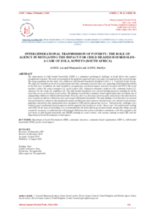ABSTRACT
The phenomenon of child headed households (CHH) is a ubiquitous pathological challenge in South Africa that requires strengthened responses. The study was grounded in the qualitative approach and a case study was employed as the research design. The target population for this study were children in child headed households identified in Zola 1, 2, 3 and Zola North, Soweto. The study also included social service professionals and other community structures that were supporting child headed households in the Zola area. In addition, the study included as its population, non-formal support structures involved with OVCY, like social auxiliary workers (8), project managers (2), social workers (10), volunteers/community caregivers (10), community leaders (2), educators (3), the clergy (2), neighbours (3). The child headed households were selected through purposive sampling for all the areas they access services from social workers. The findings revealed that community-based organisations play an eminent role of safeguarding children in child headed households. However, there is a disconnect between policy and practice that often leads to poor responses in effective child protection work around child headed households. The study findings reveal that there are internal and external policy weaknesses that impeded the quality of child protection responses. Internal issues were related to lack of proper guidelines and policies that underpinned what constituted a CHH and the appropriate services External policy challenges were related to poor coordination between agencies and the apparent lack of advocacy on the “duty to care” for professionals working with CHH. On the basis of the findings, it is recommended that the South African government should, among other things, provide a properly resourced, co-ordinated and well managed child protection system to facilitate constituency work that responds to the real needs of child headed households and SMART planning by social workers, with systemic teaming around CHH with the Department of Social Development as lead agency.

